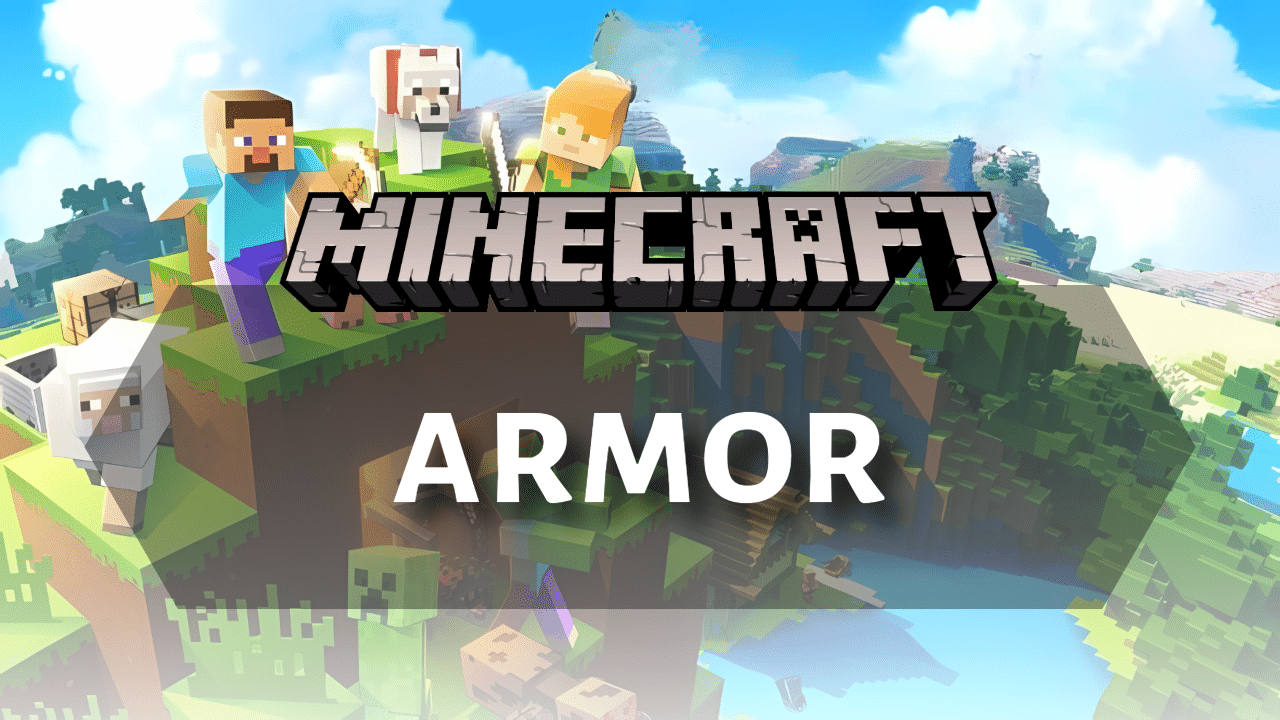
Introduction
In the vast and often dangerous world of Minecraft Bedrock Edition, armor is your primary defense against threats ranging from hostile mobs and environmental hazards to unexpected player encounters.
This comprehensive Minecraft Bedrock Armor Guide covers everything you need to know about armor in Bedrock Edition, focusing on the main pieces—helmets, chestplates, leggings, and boots—so you can make the best choices for your adventures.
Types of Main Armor
Minecraft Bedrock Edition includes several armor tiers, each offering different levels of protection and durability.
Leather Armor
Leather armor is the most basic and is crafted using leather obtained from cows, horses, llamas, and mooshrooms. It’s the only armor type that can be dyed for customization. Leather boots prevent players from sinking into powder snow, making them useful in snowy biomes.
Chainmail Armor
Chainmail armor is unique because it cannot be crafted. Instead, it can be found in buried treasure chests, dropped by armored mobs, or obtained through trading with armorer villagers. It offers slightly better protection than leather but is weaker than iron.
Iron Armor
Iron armor is a major upgrade from leather, crafted using iron ingots. Iron ore is common underground and must be smelted in a furnace to produce ingots. Iron armor can also be found in chests within structures like strongholds, villages, and shipwrecks, or dropped in raids. Armorers may sell iron armor as well.
Gold Armor
Gold armor is crafted from gold ingots, which are smelted from gold ore found underground and in the Nether. While gold armor provides decent protection, it has low durability. However, wearing at least one piece of gold armor prevents piglins from attacking in the Nether, making it valuable for Nether exploration.
Diamond Armor
Diamond armor is highly durable and protective, crafted from diamonds found deep underground. Diamond armor pieces can also be obtained from end cities and bastion remnant chests or purchased from expert-level armorer villagers. Some enchanted diamond armor pieces can be found in ancient cities.
Netherite Armor
Netherite armor is the strongest and most durable in the game. It cannot be crafted directly but must be upgraded from diamond armor using a smithing table and a netherite ingot. Netherite ingots are created from netherite scraps (obtained by smelting ancient debris found in the Nether) and gold ingots. Netherite armor offers the highest protection, is fire- and lava-resistant, and provides knockback resistance.
Parts of the Armor
Helmet
Helmets are an essential piece of armor in Minecraft: Bedrock Edition, offering protection against attacks and environmental hazards. They can be crafted using five units of the same raw material, including Leather, Iron Ingots, Gold Ingots, or Diamonds, arranged in a U-shape on a crafting table. The Turtle Shell is a unique helmet made from five Scutes, which baby turtles drop when they mature into adults. Chainmail Helmets cannot be crafted and must be obtained through villager trades, mob drops, or found in treasure chests. Netherite Helmets are created by upgrading a Diamond Helmet at a Smithing Table using a Netherite Ingot and a Netherite Upgrade Smithing Template.
ImageMaterialArmor PointsArmor ToughnessDurabilityLeather1 055Golden2 077Chainmail2 0165Iron2 0165Diamond3 2363Netherite3 3407Turtle Shell2 0275Helmets can be enchanted with general armor enchantments such as Protection, Fire Protection, Blast Protection, Projectile Protection, Unbreaking, Mending, and Thorns. Additionally, they have exclusive enchantments like Respiration, which extends underwater breathing time, and Aqua Affinity, which increases mining speed while submerged. Players can also customize their helmets with armor trims using a Smithing Table. There are 11 trim patterns and 10 different color materials, and armor trims can be duplicated using the corresponding Smithing Template, the required base block, and seven diamonds at a crafting table.
Chestplate
Chestplates offer the highest defense per armor piece, reducing damage taken by 32%. They are crafted using eight units of the same raw material, such as Leather, Iron Ingots, Gold Ingots, or Diamonds. Chainmail Chestplates, like other chainmail armor, cannot be crafted and must be found in treasure chests or acquired through villager trades. Netherite Chestplates are created by upgrading a Diamond Chestplate at a Smithing Table with a Netherite Ingot and a Netherite Upgrade Smithing Template. The Elytra can be worn in the chestplate slot but does not provide standard armor protection, allowing players to glide instead.
ImageMaterialArmor PointsArmor ToughnessDurabilityLeather3 080Golden5 0112Chainmail5 0240Iron6 0240Diamond8 2528Netherite8 3592Like other Netherite armor pieces, Netherite Chestplates are immune to fire damage. Chestplates can be enchanted with the same general armor enchantments as other pieces, including Protection, Fire Protection, Blast Protection, Projectile Protection, Unbreaking, Mending, and Thorns. They can also be customized with armor trims at a Smithing Table, using the same 11 trim patterns and 10 color materials available for other armor pieces.
Leggings
Leggings provide 24% damage reduction, making them an important piece of armor for survival. They require seven units of the same raw material, such as Leather, Iron Ingots, Gold Ingots, or Diamonds, to be crafted. Chainmail Leggings are not craftable and must be acquired through villager trades, mob drops, or treasure chests. Netherite Leggings are created by upgrading Diamond Leggings using a Smithing Table with a Netherite Ingot and a Netherite Upgrade Smithing Template.
ImageMaterialArmor PointsArmor ToughnessDurabilityLeather2 075Golden3 0105Chainmail4 0225Iron5 0225Diamond6 2495Netherite6 3555Netherite Leggings, like all Netherite armor, are resistant to fire damage. Leggings can be enchanted with the same general armor enchantments as other pieces and have one unique enchantment, Swift Sneak III, which increases movement speed while sneaking. This enchantment is only found in ancient cities. Players can further customize their leggings using armor trims, following the same process as helmets and chestplates.
Boots
Boots are another vital piece of armor, reducing damage by 8% while also providing unique benefits. They require four units of the same raw material—Leather, Iron Ingots, Gold Ingots, or Diamonds—to craft. Chainmail Boots, like other chainmail armor, cannot be crafted and must be found in treasure chests or traded with villagers. Netherite Boots are obtained by upgrading Diamond Boots at a Smithing Table with a Netherite Ingot and a Netherite Upgrade Smithing Template. Leather Boots can sometimes be obtained as a junk item while fishing.
ImageMaterialArmor PointsArmor ToughnessDurabilityLeather1 065Golden1 091Chainmail1 0195Iron2 0195Diamond3 2429Netherite3 3481Netherite Boots are resistant to fire damage, making them highly durable in dangerous environments. Wearing Leather Boots allows players to walk on powder snow without sinking, which is especially useful in snowy biomes.
Boots can be enchanted with general armor enchantments, as well as unique enchantments such as Feather Falling IV, which reduces fall damage, Soul Speed III, which increases movement speed on soul sand and soul soil, Depth Strider III, which increases underwater movement speed, and Frost Walker II, which turns water into frosted ice. Frost Walker is incompatible with Depth Strider, so players must choose between them.
Crafting Recipes for Main Armor
Most armor types, except chainmail and netherite, can be crafted on a crafting table using the corresponding materials. The helmet is made with five units in a U-shape, the chestplate with eight units filling all slots except the top middle, leggings with seven units in a U-shape plus one in the top middle, and boots with four units placed in an inverted L-shape on both sides. Crafting a full set of iron armor requires 24 iron ingots, while a full set of diamond armor needs 24 diamonds.
Obtaining Non-Craftable Chainmail Armor
Chainmail armor cannot be crafted but can be found in buried treasure chests, dropped by mobs wearing it (such as zombies, skeletons, and zombie piglins), or purchased from armorer villagers at the novice and journeyman levels.
Upgrading to Netherite Armor
To upgrade diamond armor to netherite, you must first obtain ancient debris in the Nether, usually found between levels 8 and 22. Smelting ancient debris gives netherite scraps, which can be combined with gold ingots to create netherite ingots. You will also need a netherite upgrade smithing template, found in bastion remnants. These templates can be duplicated using a crafting table, requiring one template, one netherrack, and seven diamonds. To upgrade your armor, place the diamond piece, a netherite upgrade template, and a netherite ingot into a smithing table.
Protection Values and Durability of Main Armor
Armor provides protection points, where each point reduces incoming damage by 4%, up to a maximum of 80% reduction. Leather provides the least protection, while netherite provides the most. Durability also varies, with netherite being the most durable. Additionally, diamond and netherite armor grant armor toughness, reducing damage from strong attacks. Netherite armor also adds knockback resistance.
Armor TypeProtection PointsDurabilitySpecial PropertiesLeather3 (Full Set)56-80Can be dyed, prevents powder snow sinking (boots)Chainmail6 (Full Set)120-240Cannot be crafted, only found or tradedIron15 (Full Set)165-495Stronger than chainmail, commonly found and craftedGold11 (Full Set)91-196Piglins remain passive if wornDiamond20 (Full Set)363-795High durability, strong protectionNetherite20 (Full Set)407-863Fire resistance, knockback resistance, highest durabilitySpecial Properties of Main Armor Types
Some armor types have unique benefits beyond protection. Leather armor can be dyed for customization, and leather boots prevent sinking in powder snow. Gold armor makes piglins in the Nether passive toward you. Netherite armor is immune to fire and lava, making it ideal for Nether travel. The turtle shell helmet, crafted from scutes dropped by baby turtles, grants water breathing for 10 extra seconds while underwater.
Armor Trims: Customizing Your Look
Armor trims in Minecraft Bedrock Edition allow players to customize their armor with unique visual patterns and colors. Applied through the Smithing Table, trims require three components: an armor piece, a Smithing Template (which determines the pattern), and a material (which sets the color).
This system enables deep personalization, though it does not provide any additional protective benefits. Most armor sets, including turtle shells, can be trimmed, but leather armor and elytras remain uncustomizable.
There are 11 different armor trim designs, each found in specific structures such as shipwrecks, desert pyramids, and ancient cities.
Best Enchantments for Armor
Repairing Armor in Bedrock Edition
Armor can be repaired in different ways. A crafting table combines two damaged pieces into one with slightly higher durability but removes enchantments. Anvils repair armor using the corresponding material while keeping enchantments intact but requiring experience levels. Grindstones also combine two armor pieces but remove enchantments.
Smelting Armor
Iron, gold, and chainmail armor can be smelted in a furnace to yield nuggets of their respective materials. This allows you to recover some resources from unwanted or broken armor.
Displaying Armor
Armor Stand
Armor stands can be crafted using smooth stone slabs and sticks. Right-clicking (or tapping on mobile) on an armor stand with a piece of armor equips it onto the stand, making it a great way to display rare or enchanted armor.
Armor for Pets
Pets such as horses, donkeys, and llamas can wear armor for added protection, helping them survive longer in dangerous situations.
Horse Armor
Horse armor comes in leather, iron, gold, and diamond variants, increasing a horse’s defense without degrading like player armor. It can be found in structures such as dungeons, bastions, and villages, making exploration a key way to obtain it. Donkeys and mules, however, cannot wear armor, though they can carry chests for additional storage.
Wolf Armor
Chainmail armor is unique because it cannot be crafted. Instead, it can be found in buried treasure chests, dropped by armored mobs, or obtained through trading with armorer villagers. It offers slightly better protection than leather but is weaker than iron.
Llama
Iron armor is a major upgrade from leather, crafted using iron ingots. Iron ore is common underground and must be smelted in a furnace to produce ingots. Iron armor can also be found in chests within structures like strongholds, villages, and shipwrecks, or dropped in raids. Armorers may sell iron armor as well.
Conclusion
Choosing the right armor in Minecraft Bedrock Edition is essential for survival. Understanding the strengths of different materials, how to obtain and upgrade gear, and how to maintain and customize it through trims and enchantments can significantly improve your gameplay. Whether you’re exploring caves, venturing into the Nether, or fighting off mobs, a well-prepared set of armor is your best protection. Use this Minecraft Bedrock Armor Guide to equip yourself wisely and take on the dangers of Minecraft with confidence.
If you’re looking for more guides, be sure to explore the website for more tips and tricks. Enjoy your adventure, and happy mining!
Frequently Asked Questions(FAQs)
How to dye wolf armor in Minecraft Bedrock
Place the cauldron in your world and add water to it.
Then, use any dye you want on the cauldron and the water will change its color.
How to apply armor trim
To add an Armor Trim, open a Smithing Table. You’ll see an extra slot in the interface. Drop the Smithing Template into that slot first, then place the piece of armor you want to customize in the next one. Finally, insert the material you want.













